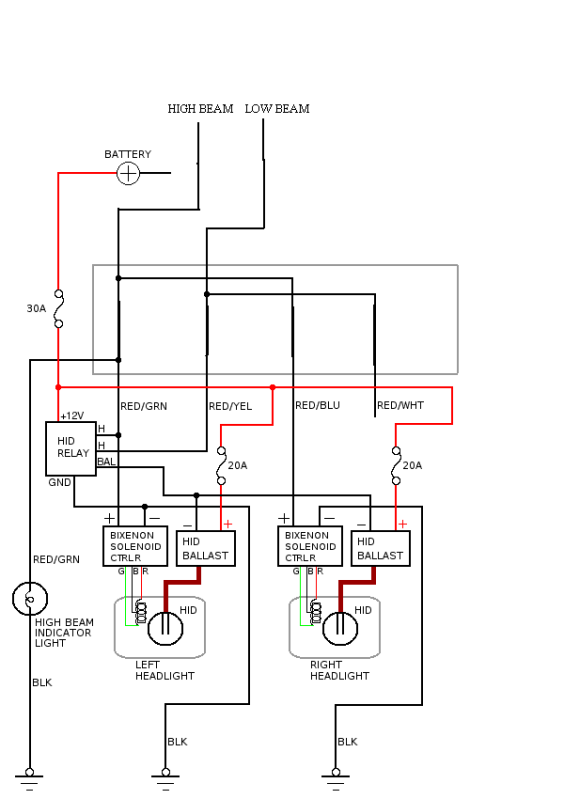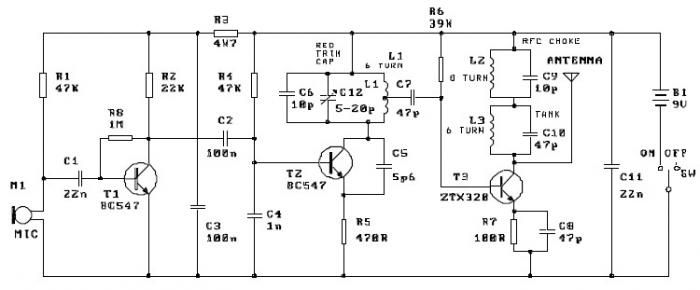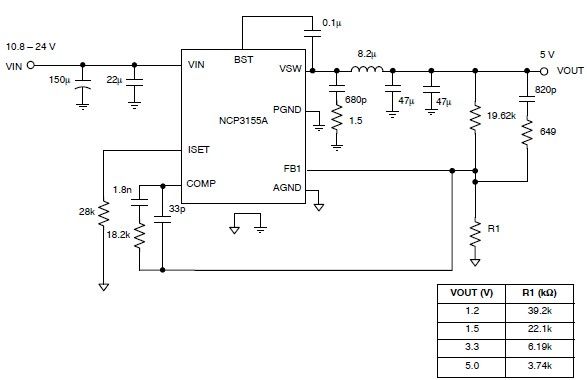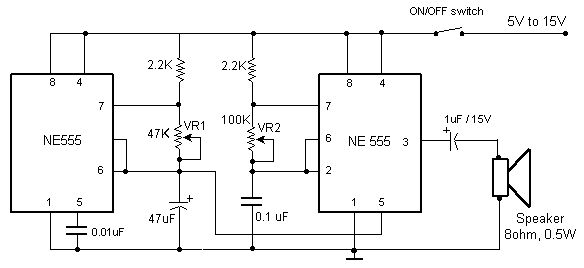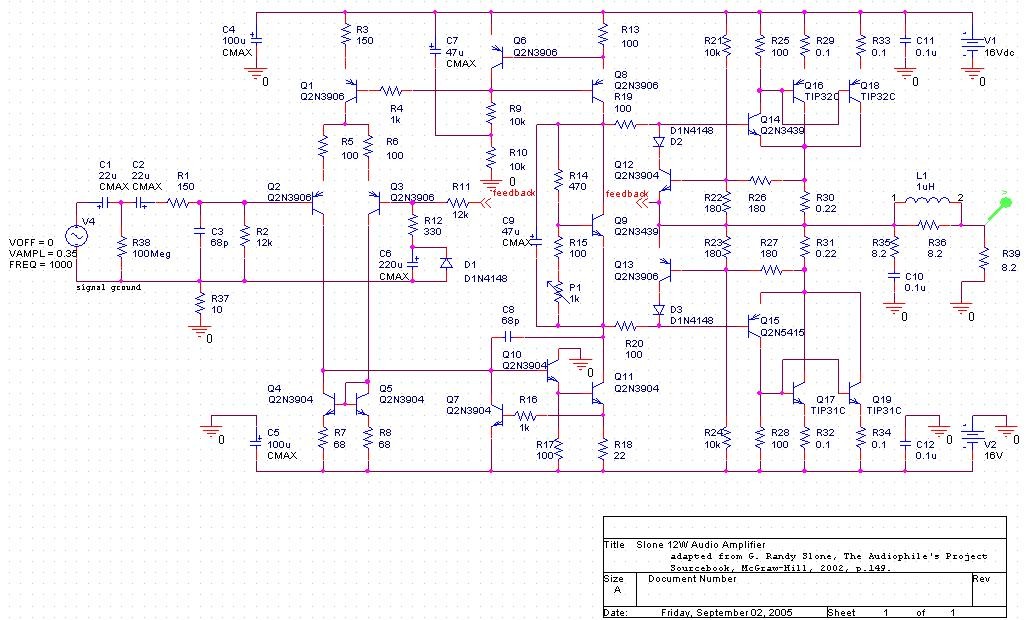
Electronic Die
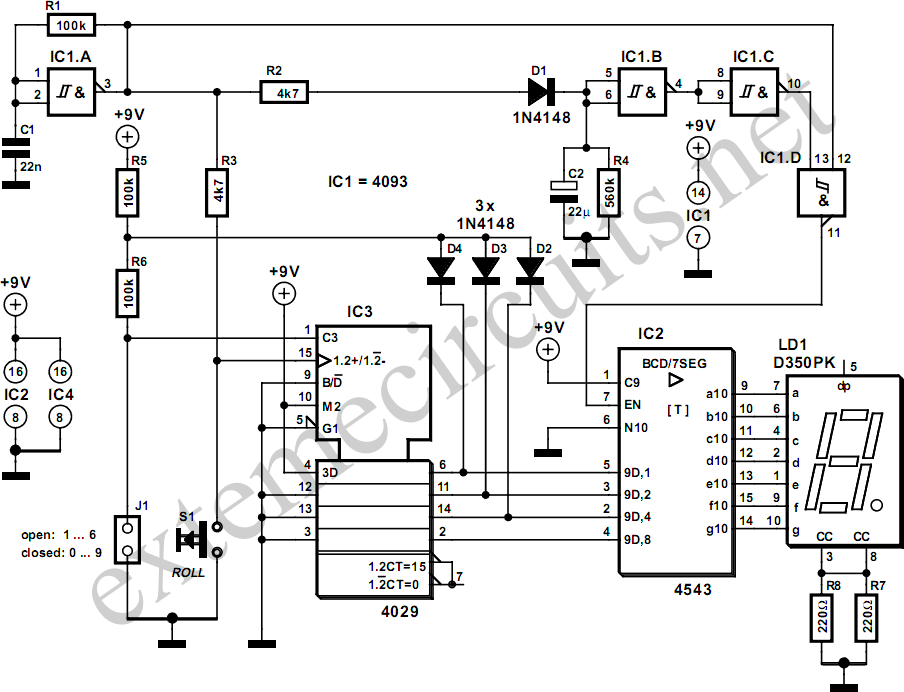
The simplicity of a traditional die makes it exceptionally difficult to create a fully equivalent electronic version, primarily because an electronic version requires a power supply and a collection of electronic components that occupy a significantly larger volume than a standard die. This article describes an electronic die that can be built using standard components or SMDs as desired, and which closely resembles a traditional die in the latter case. Despite its simplicity, this electronic die incorporates several interesting features. For instance, the range of spots can be increased from 1-6 to 0-9 using a jumper, and it has a standby function that disables the display approximately 8 seconds after the die has been thrown to save energy. The electronic die also uses energy efficiently by driving the display in pulsed mode. As a result of these features, the current consumption of the circuit is approximately 25 mA during operation and 12 mA in standby, making it easily powered by a 9-V battery. The circuit consists of the following parts: a free-running oscillator (IC1a), additional logic for driving the display (IC1c & IC1d), a timer (IC1b), a counter (IC3), and a display decoder (IC2). The oscillator is very simple. Its frequency, determined by R1 and C1, is approximately 225 Hz, with a duty cycle of around 50-60 percent. The signal from the oscillator acts as a clock signal for the counter (via R2) and a blanking signal for the display decoder (via IC1d). However, the counter will not count as long as the throw switch (S1) remains closed, since the clock input of IC3 is grounded by S1. The blanking input of the display decoder is driven by a pulse waveform, so the display is illuminated only about 50 percent of the time, yet appears constantly illuminated due to the high clock frequency. The standby mode operates as follows: while there is a signal on the clock input of the counter (S1 pressed), the output of gate IC1b is low, and the display is enabled. When S1 is released, the counter stops, and a number is shown on the display. However, the clock pulses will have charged C2 via D1, and C2 will slowly discharge through R4. After approximately 8 seconds, the output of gate IC1b will go high, causing the display to be blanked. The design of the counter is relatively simple, wired as an up counter by connecting the U/D pin to VCC. The preset inputs (pins 4, 12, 13, and 3) are configured to binary 0001, and the counter typically has a counting range of 0-9 (pin 9 connected to ground). Diodes D2, D3, and D4, combined with resistor R5, act as a logic AND gate, so if the value of the counter exceeds 6, the preset value of 1 is latched into the counter, causing it to count again from 1 to 6. This only occurs if jumper J1 is open; if closed, the preset pulse on PREN is suppressed, and the counter range remains 0-9. The A, B, C, and D inputs of the decoder IC (IC2) are driven directly by the counter. The series resistors typically used for the individual segments of the display are instead placed in the common-cathode lead (R7 & R8). This design reduces the number of resistors needed, although it may lead to brightness variations depending on the displayed number. If the segment current is sufficiently high, saturation occurs, and this brightness variation becomes less noticeable. The Blank input (BL) controls whether the display is enabled. If SMD technology is employed for construction, it will not affect the schematic diagram but will influence component selection. In this scenario, SMD components must be used for the resistors and C1, diodes must be replaced with BAS32 types, and BT versions of ICs IC1 and IC3 should be used instead of conventional types. An SMD version of C2 was not utilized in the prototype due to the high cost of SMD electrolytic capacitors, which are typically sold in lots of 10, similar to other passive components. It is also advisable to use a socket for the display in the SMD version of the electronic die to maximize space under the display and further reduce the circuit board dimensions. Any suitable DC power source providing a voltage of 5 to 15 V may be used as a power supply. Due to the circuit's low current consumption, a 9-V battery will have a long lifespan.
The electronic die circuit is designed to mimic the behavior of a traditional die while incorporating modern electronic features to enhance functionality and efficiency. The core of the circuit is the free-running oscillator, which generates a stable clock signal that drives the counter and manages the display's illumination. The use of a timer allows the system to enter a low-power standby mode, thereby conserving energy when not in active use. The counter's design, with the ability to switch between counting ranges, adds versatility to the electronic die, accommodating various game requirements. The interaction between the counter and the display decoder is optimized to ensure that the display remains visually appealing and functional, even with the pulsed operation. The choice of components, whether standard or SMD, provides flexibility in design and can cater to different manufacturing preferences. The overall layout and component arrangement are critical for minimizing size while maintaining performance, ensuring that the electronic die remains user-friendly and practical for everyday use.The simplicity of a traditional die makes it exceptionally difficult to create a fully equivalent electronic version, if only because an electronic version requires a power supply and a collection of electronic components that occupy a much larger volume than a normal die. This article describes an electronic die that can be built using normal com ponents or SMDs as desired, and which comes very close to having the same format as a traditional die in the latter case. Despite its simplicity, this electronic die incorporates several interesting features. For instance, the range of spots` can be increased from 1 6 to 0 9 using a jumper, and it has standby function that disables the display approximately 8 seconds after the die has been thrown`, in order to save energy.
The electronic die also uses energy efficiently by driving the display in pulsed mode. As a result of the latter two features, the current consumption of the circuit is approximately 25 mA in use and 12 mA in standby. This means that it can easily be powered by a 9-V battery. The circuit consists of the following parts: a free-running oscillator (IC1a), additional logic for driving the display (IC1c & IC1d), a timer (IC1b), a counter (IC3) and a display decoder (IC2).
The oscillator is very simple. Its frequency, which is determined by R1 and C1, is approximately 225 Hz, with a duty cycle of around 50 60 percent. The signal from the oscillator acts as a clock signal for the counter (via R2) and a blanking signal for the display decoder (via IC1d).
However, the counter will not count as long as the throw` switch (S1) remains closed, since the clock input of IC3 is grounded by S1. The blanking input of the display decoder is driven by a pulse waveform, so the display is in principle illuminated only around 50 percent of the time, but it appears to be constantly illuminated due to the high clock frequency.
The standby mode works as follows. As long as there is a signal on the clock input of the counter (S1 pressed), the output of gate IC1b is low and the display is enabled. If S1 is released, the counter stops and a number will be shown on the display. However, the clock pulses will have charged C2 via D1, and C2 will slowly discharge via R4. After approximately 8 seconds, the output of gate IC1b will go high, causing the display to be blanked.
The design of the counter is relatively simple. It is wired as an up counter by connecting the U/D pin to VCC. The preset inputs (pins 4, 12, 13 and 3) are configured to binary 0001`, and the counter normally has a counting range of 0 9 (pin 9 connected to ground). Diodes D2, D3 and D4, in combination with resistor R5, act as a logic AND gate, so if the value of the counter is greater than 6, the preset value of 1 is latched into the counter and it starts to count again from 1 to 6.
This only happens if jumper J1 is open. If it is closed, the preset pulse on PREN is suppressed and the counter range is 0 9. The A, B, C and D inputs of the decoder IC (IC2) are driven directly by the counter. The series resistors normally used for the individual segments of the display are instead placed in the common-cathode lead (R7 & R8). This has the advantage of allowing the number of resistors to be reduced, although it has the drawback that the brightness of the display depends on the displayed number.
If the segment current is sufficiently large, (light) saturation occurs and this brightness variation is no longer noticeable. The Blank input (BL) controls whether the display is enabled. If you choose to build this circuit using SMD technology, that will not affect the schematic diagram, but it will naturally affect the choice of components.
In this case, SMD components must be used for the resistors and C1, the diodes must be replaced by BAS32 types, and BT versions of ICs IC1 IC3 must be used instead of conventional types. An SMD version of C2 was not used in the prototype, since SMD electrolytic capacitors are expensive, and normally they are only sold in lots of 10, just like other passive components.
It is also recommended to use a socket for the display of the SMD version of the electronic die, to allow the space under the display to also be used and the dimensions of the circuit board to be further reduced. Any desired DC power source providing a voltage of 5 to 15 V can be used as a power supply. Due to the low current consumption of the circuit, a 9-V battery will last quite a long time. 🔗 External reference
The electronic die circuit is designed to mimic the behavior of a traditional die while incorporating modern electronic features to enhance functionality and efficiency. The core of the circuit is the free-running oscillator, which generates a stable clock signal that drives the counter and manages the display's illumination. The use of a timer allows the system to enter a low-power standby mode, thereby conserving energy when not in active use. The counter's design, with the ability to switch between counting ranges, adds versatility to the electronic die, accommodating various game requirements. The interaction between the counter and the display decoder is optimized to ensure that the display remains visually appealing and functional, even with the pulsed operation. The choice of components, whether standard or SMD, provides flexibility in design and can cater to different manufacturing preferences. The overall layout and component arrangement are critical for minimizing size while maintaining performance, ensuring that the electronic die remains user-friendly and practical for everyday use.The simplicity of a traditional die makes it exceptionally difficult to create a fully equivalent electronic version, if only because an electronic version requires a power supply and a collection of electronic components that occupy a much larger volume than a normal die. This article describes an electronic die that can be built using normal com ponents or SMDs as desired, and which comes very close to having the same format as a traditional die in the latter case. Despite its simplicity, this electronic die incorporates several interesting features. For instance, the range of spots` can be increased from 1 6 to 0 9 using a jumper, and it has standby function that disables the display approximately 8 seconds after the die has been thrown`, in order to save energy.
The electronic die also uses energy efficiently by driving the display in pulsed mode. As a result of the latter two features, the current consumption of the circuit is approximately 25 mA in use and 12 mA in standby. This means that it can easily be powered by a 9-V battery. The circuit consists of the following parts: a free-running oscillator (IC1a), additional logic for driving the display (IC1c & IC1d), a timer (IC1b), a counter (IC3) and a display decoder (IC2).
The oscillator is very simple. Its frequency, which is determined by R1 and C1, is approximately 225 Hz, with a duty cycle of around 50 60 percent. The signal from the oscillator acts as a clock signal for the counter (via R2) and a blanking signal for the display decoder (via IC1d).
However, the counter will not count as long as the throw` switch (S1) remains closed, since the clock input of IC3 is grounded by S1. The blanking input of the display decoder is driven by a pulse waveform, so the display is in principle illuminated only around 50 percent of the time, but it appears to be constantly illuminated due to the high clock frequency.
The standby mode works as follows. As long as there is a signal on the clock input of the counter (S1 pressed), the output of gate IC1b is low and the display is enabled. If S1 is released, the counter stops and a number will be shown on the display. However, the clock pulses will have charged C2 via D1, and C2 will slowly discharge via R4. After approximately 8 seconds, the output of gate IC1b will go high, causing the display to be blanked.
The design of the counter is relatively simple. It is wired as an up counter by connecting the U/D pin to VCC. The preset inputs (pins 4, 12, 13 and 3) are configured to binary 0001`, and the counter normally has a counting range of 0 9 (pin 9 connected to ground). Diodes D2, D3 and D4, in combination with resistor R5, act as a logic AND gate, so if the value of the counter is greater than 6, the preset value of 1 is latched into the counter and it starts to count again from 1 to 6.
This only happens if jumper J1 is open. If it is closed, the preset pulse on PREN is suppressed and the counter range is 0 9. The A, B, C and D inputs of the decoder IC (IC2) are driven directly by the counter. The series resistors normally used for the individual segments of the display are instead placed in the common-cathode lead (R7 & R8). This has the advantage of allowing the number of resistors to be reduced, although it has the drawback that the brightness of the display depends on the displayed number.
If the segment current is sufficiently large, (light) saturation occurs and this brightness variation is no longer noticeable. The Blank input (BL) controls whether the display is enabled. If you choose to build this circuit using SMD technology, that will not affect the schematic diagram, but it will naturally affect the choice of components.
In this case, SMD components must be used for the resistors and C1, the diodes must be replaced by BAS32 types, and BT versions of ICs IC1 IC3 must be used instead of conventional types. An SMD version of C2 was not used in the prototype, since SMD electrolytic capacitors are expensive, and normally they are only sold in lots of 10, just like other passive components.
It is also recommended to use a socket for the display of the SMD version of the electronic die, to allow the space under the display to also be used and the dimensions of the circuit board to be further reduced. Any desired DC power source providing a voltage of 5 to 15 V can be used as a power supply. Due to the low current consumption of the circuit, a 9-V battery will last quite a long time. 🔗 External reference
